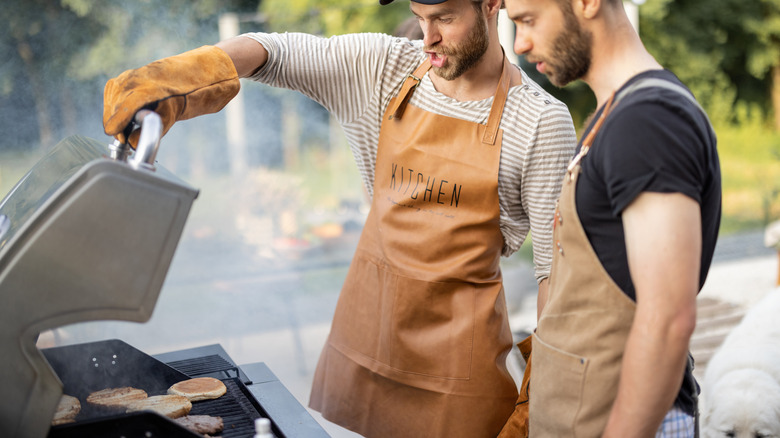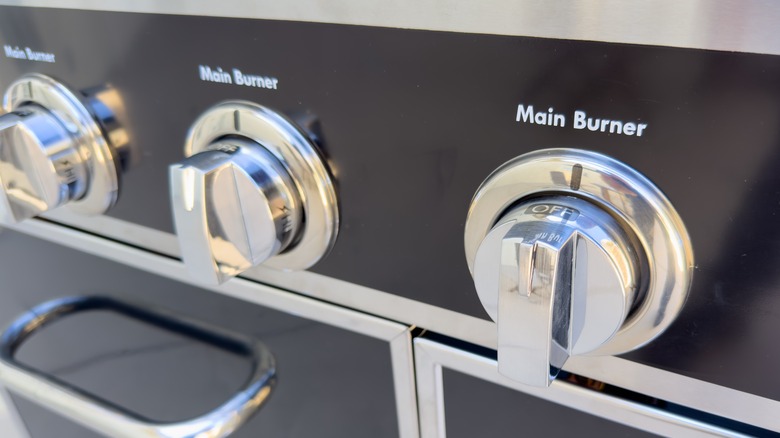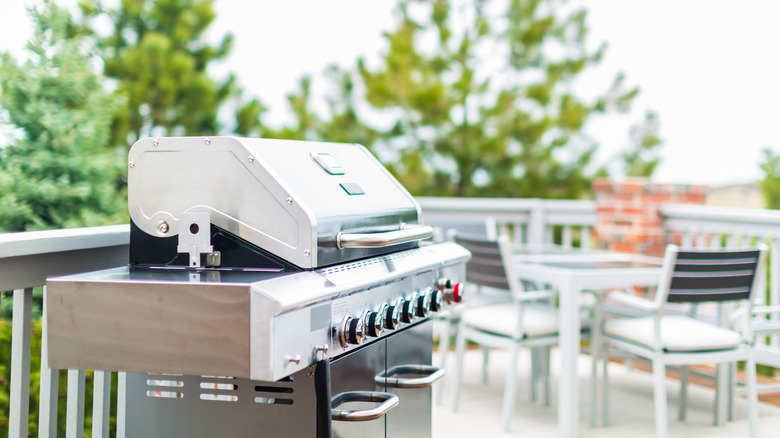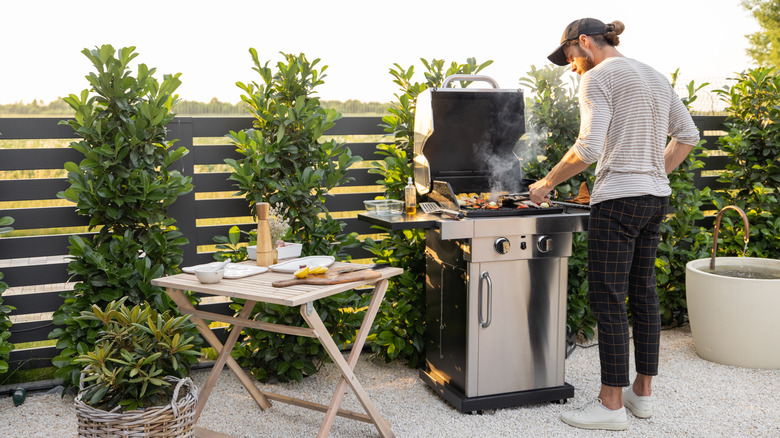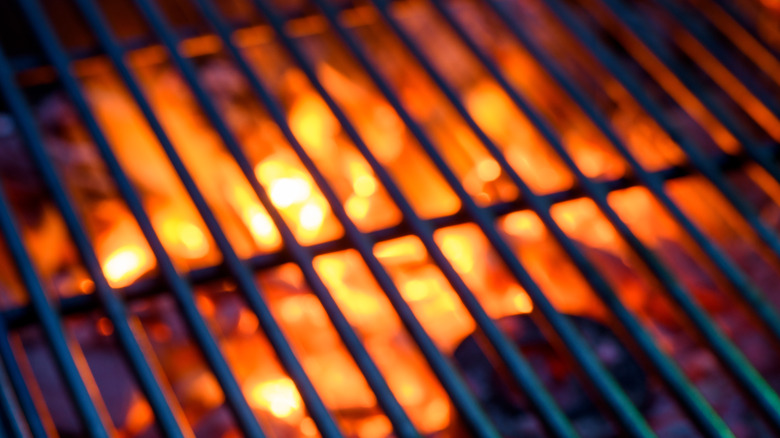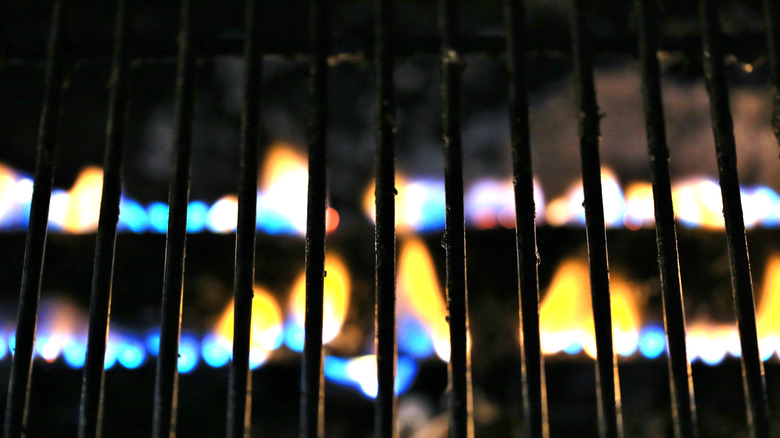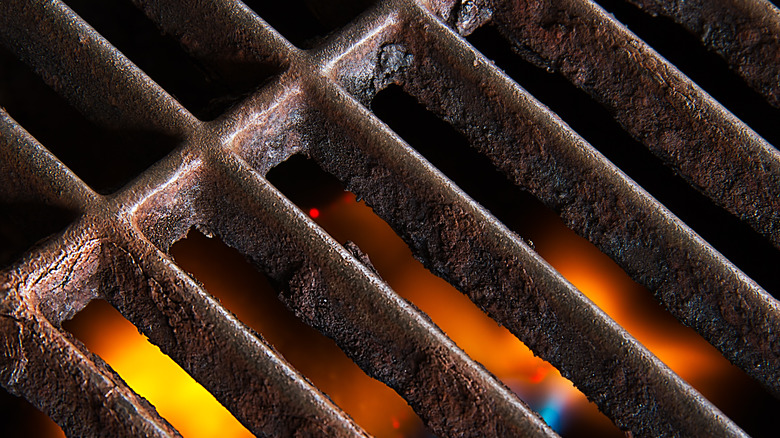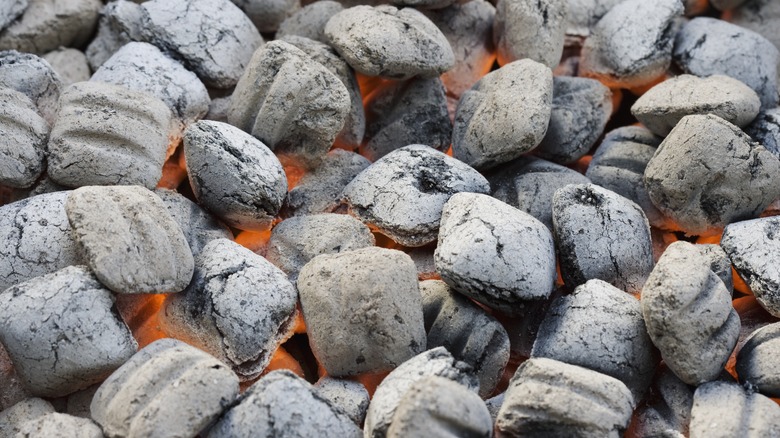7 Big Mistakes You're Probably Making When Cooking Hamburgers On A Gas Grill
Sooner or later, most of us will inevitably ask ourselves if it's better to choose a gas or charcoal grill. Regardless of your stance on this issue, there's no doubt that when it comes to convenience, it's hard to beat cooking on a gas grill. After running grill stations as a line cook and cooking countless cuts of steak and burgers, I came to fully appreciate the convenience, accuracy, and flexibility of gas grills. Compared to charcoal, cooking with gas gives you more precise temperature control, making it easier to create different heat zones. Gas burners make it super simple to create spots for both direct and indirect heat, which comes in handy for cooking all types of food, including burgers.
Despite the convenience and relative simplicity of cooking on gas grills, there are still plenty of mistakes to be made along the way — and because we're cooking with open flames fueled by a tank of propane, some of those mistakes can be downright dangerous. But even simple mistakes that are less severe can still have horrible outcomes that can ruin your burgers. We want to avoid that at all costs, right? The good news is that I've come up with a list of big mistakes to help steer you in the right direction and save the day.
1. Cooking at the wrong temperature
When it comes to temperature and timing, it's always important to consider the ingredients that you're working with. Ground beef doesn't typically take very long to cook properly. The grinding process has minced up the meat into small pieces, which makes it easier for the heat of the grill to permeate the beef. To cook some of the best burger recipes, I like to start them out over low heat for a few minutes. This is usually around 225 F. That way, the beef can slowly cook and retain its juices.
After a few minutes over low heat, I'll then slide my burgers over to a hot spot on the grill. The temperature of a hot spot is usually around 400 F. This approach — cooking meat over low heat and finishing it over high heat — is one of my favorite tricks with a gas grill and it's referred to as reverse searing. This process makes it easier to cook meat but keep it juicy, while also developing a crust towards the end without overcooking it. This is particularly useful when you're cooking thicker burgers. To get an accurate temperature reading for your different heat zones, I'd recommend using a digital infrared thermometer.
2. Closing the lid too much
Closing the lid can be a good option, but it all depends on what you're cooking and what you're trying to accomplish. If you know how to grill chicken, then you know that keeping the lid closed for longer periods of time makes perfect sense, because chicken typically takes a while to fully cook through. Closing the lid will allow heat to accumulate around the grill, slowly baking the chicken so that it fully cooks through to a safe temperature for consumption without burning.
Cooking burgers, though, is a whole different ball game. There's really no need to keep the lid closed for a long period of time for burgers, unless you want them to end up tasting like a hockey puck. Closing the lid on a grill essentially turns it into an oven and the last thing you want to do is bake your burgers into oblivion. Whenever I grill burgers, I really only close the lid once — at the end of cooking, only for a minute or so, to help melt the cheese.
3. Not enough clearance around the grill
There's always some level of inherent risk to everything we do in life, and the same is true for grilling with gas. That said, dangers can often be mitigated with some basic common sense and safety measures. One of the biggest mistakes people make is choosing a bad spot to position their gas grill. What constitutes a bad spot, exactly? Anywhere that's too close to other objects — especially those that are flammable.
If you have a shed in your backyard, for example, it's probably not a good idea to put your grill close to it. Long-term exposure to heat could spark a fire that can easily spread to your shed and other nearby objects. Avoid putting your grill next to plants, trees, and wooden objects. For the sake of safety, gas grills need to have enough space from your house combustibles, and other nearby structures that may prevent airflow or catch fire. The grill should also be positioned far away from doors and windows so that fumes don't enter the home. It's often recommended to have at least 5-10 feet of clearance around your grill, but the more the better.
4. Causing a flare up
A flare up usually happens when fat drips down into the fire of a grill. And because burgers tend to be quite fatty, they can easily cause flare ups in a gas grill — which can be dangerous because the propane tank is often close by.
Flare ups can happen for a number of reasons. If the grill hasn't been properly cleaned, fatty residue can build up inside of the grill that causes smoke and can eventually ignite into a grease fire. Grease fires in propane grills are even more dangerous than charcoal, because the propane tank can explode if the fire grows too out of control. If a flare up occurs, immediately cover the grill to cut off the oxygen. If it's safe to do so, you can also turn off the burners and turn off the propane.
The best thing you can do to stop flare ups is to prevent them by keeping your grill clean and also by closely monitoring the temperature of your grill while you're cooking. Be sure to check out our beginners' guide on how to grill, for some other handy tips.
5. Using too much direct heat
Becoming a grill master mostly comes down to understanding how to use direct heat and indirect heat. When your burgers are being licked by flames on the bottom grill grate close to the burners, that's direct heat. The heat is directly making contact with your burgers. But if you put your burgers on a cool side of the grill or up on the warming rack where it cooks at a much lower temperature, that's indirect heat.
I think a lot of people cook their burgers over direct heat for too long. Of course, there is nothing inherently wrong about cooking with direct heat — the problem comes down to timing. Cooking burgers over direct heat for too long will end up drying burgers out and burning them, which is obviously not a great outcome. If you're cooking burgers over direct heat, be mindful of how long they're there for and keep a close eye on them.
6. Not preheating the grill
Some people make the mistake of underestimating the importance of preheating the grill. Preheating the grill not only helps burn off any gunk left behind from your last grilling session, but getting the grates hot will also prevent your burgers from sticking. It's one of those things that's not difficult to do, but can be easy to forget about.
To preheat your grill, simply turn it on and let it warm up for about 10 or 15 minutes. I usually turn the burners up to high and keep the lid closed while it heats up. Once it's fully heated, I open the lid and run a grill brush over the grates to give them another scrub. Once the grates are smooth and clean, I'll turn the heat down a bit, douse a paper towel with cooking oil, and then use some tongs to rub the oil along the grill's metal grates. It's important to do this quickly and carefully, because you don't want the paper towel to catch fire. Preheating the grill and giving the grates a light coat of oil sets everything up for a smooth grilling session to make some restaurant-quality burgers.
7. Assuming it's the same as cooking with charcoal
There are some major differences between cooking on a charcoal grill and cooking on a gas grill, and assuming they're both the same can lead to disastrous results. The most glaring difference between them is the temperatures they can reach. A charcoal grill can hit up to 1,200 F, whereas a gas grill typically reaches less than half of that.
This means that it's much, much easier to burn your burgers on a charcoal grill. As a result, if you're used to cooking over charcoal, you may find that cooking with gas is a bit more forgiving if you accidentally leave your burgers on the grill a little too long. At the same time, achieving a tasty char on your burgers can be more challenging, since gas grills can't reach the same high temperatures as charcoal.
Cooking over charcoal also infuses burgers with a smoky flavor that gas grills can't achieve on their own. If you want to give your burgers a smokier flavor on your gas grill, you can wrap some wood chips in foil or put them in a metal smoking tube on the grill. The wood will slowly smolder inside of your grill and add a smoky taste to your burgers that can make them even more flavorful.
